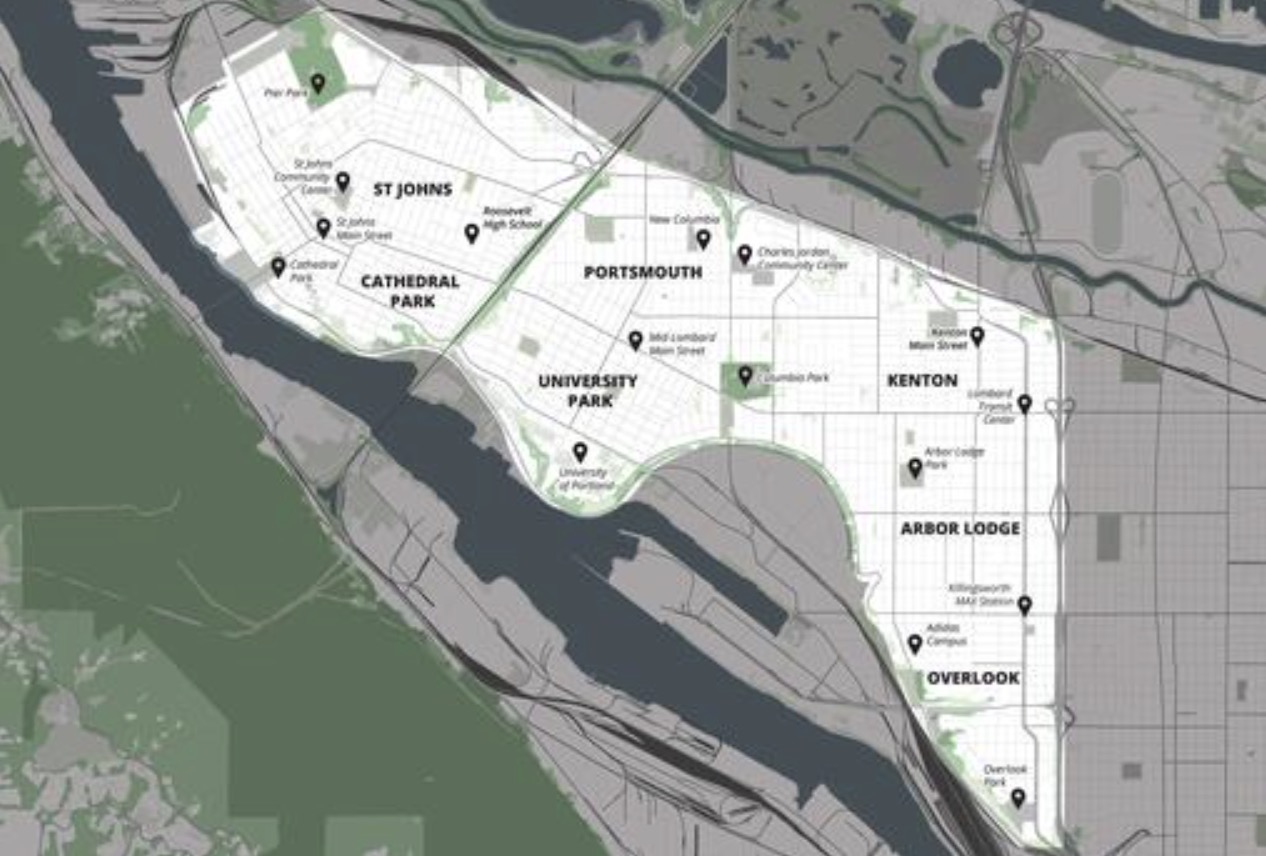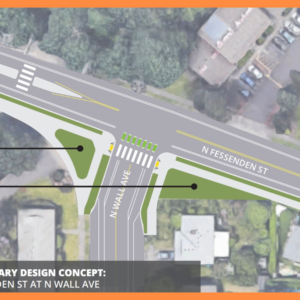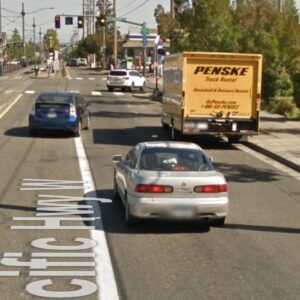
“This is a huge deal.”
– Mike Serritella, PBOT
The Portland Bureau of Transportation has scored another windfall from the Portland Clean Energy Fund (PCEF). On Tuesday evening, at the monthly meeting of the city’s Bicycle Advisory Committee, PBOT announced they’ve received a $5 million grant to implement bicycling and walking projects from the North Portland in Motion Plan.
“This is a huge deal,” said PBOT Senior Planner Mike Serritella, who leads the project.
PCEF is managed by the Bureau of Planning and Sustainability (BPS). It’s funded by revenue the city collects from large retailers (1% tax on corporations with $1 billion in national revenue and $500,000 in revenue in Portland) and is dedicated to “community-led projects that reduce carbon emissions, create economic opportunity, and help make our city more resilient as we face a changing climate.” The fund plans to award $750 million in grants over five years.
NPIM launched in 2021 and PBOT released a slate of recommended projects in May 2023. While the projects are very exciting, this is just a planning document that comes without any built-in funding commitment. PBOT has many plans like this on the shelf gathering dust, just waiting for the funding stars to align. Now they have.
Because PBOT is so accustomed to operating with limited resources, many of the projects recommended in NPIM are relatively inexpensive. “These are small-scale projects identified in the plan,” Serritella said at the meeting. “So that $5 million commitment gets us a huge way forward on the plan.”
In April, the city’s Bicycle Advisory Committee BAC wrote a letter to Mayor Ted Wheeler and the rest of city council that stated: “Adopting this plan is a critical part of ensuring a long overdue vision for safe mobility in the quadrant.”
The funding comes from PCEF’s Strategic Program 30: Active Transportation and Small Capital Projects and is part of a tranche of PCEF grants PBOT won earlier this year. The grant marks just the latest good news from PCEF when it comes to bicycling and transportation funding. In May 2024 the fund was a lifesaver for the PBOT budget when it injected $49 million to PBOT projects and programs. PCEF is funding a $20 million e-bike rebate program, and its community grants have injected millions into local transportation nonprofits.
I haven’t seen the application and it’s not clear to me yet which specific NPIM projects PBOT will build with this $5 million. But with Serritella and a solid crew at the helm, and with lots of momentum behind the projects in the plan, I have no doubt this amazing funding news will lead to key upgrades in north Portland in a short time-frame.
Some projects in the plan have already been built. And last night Serritella said, “We’ll continue to build more projects as soon as it stops raining.”
The NPIM plan is expected to be considered for official adoption by Portland City Council in December.







Thanks for reading.
BikePortland has served this community with independent community journalism since 2005. We rely on subscriptions from readers like you to survive. Your financial support is vital in keeping this valuable resource alive and well.
Please subscribe today to strengthen and expand our work.
After visioning sessions, planning meetings, fact finding trips, public hearings, third party consultant and engineering fees, vendor bidding workshop, a thorough analysis of DEI, houseless, and indigenous peoples impacts, and an awareness ciclovia/street fair in the general vicinity, will PBOT get another grant for the actual construction?
I’m kidding…kind of.
Dude that’s such a misguided bit of snark. The entire point of these “In Motion” plans is that all that stuff has already been done. This grant is a textbook example of why they did the plan… so that when a funding opportunity comes up they are ready to capitalize on it! If it were spring, I bet work orders and bids would already be going out.
Parts of NOPIM have already been constructed/are in construction now. That plan came out of the gates with construction funding attached.
Yes, thanks. I’m aware some of the projects have already been built, and I think I say that in the story. But while there may have been funding available out of the gate, the plan itself didn’t come with commitments attached to it. AFAIK.
No, it isn’t misguided – it’s exactly what happened to most of the EPIM bike project funding. The city got grants from the state and Metro, then spent the next 5-8 years redesigning (again and again) the same projects, using up funds to pay staff to redesign, consult, have open houses, etc, until half the funds ran out, and delayed the 130s and 4M bikeways by over 10 years.
The Cully/57th bikeway was delayed with the same lame tactics for 15 years, and there is one on Barbur at Gibbs delayed by 48 years. PBOT has an incredible record on delays and making up excuses.
I hear you. But EPIM was the first one wasn’t it? And it was many years ago. PBOT evolves and I think they’ve gotten really good at the “In Motion” process. I’m not defending the delays and excuses, just trying to add some info and clarity.
PBOT has gotten good at creating “In Motion” plans, they just aren’t very good at implementing their portions of the plans. It’s not just EPIM, but SWIM too. And then look at how they spend money when they do implement a project, such as the one you cite:
As far as I can tell, the bike portion is mainly a bit of paint. Most of the cost is being used to rebuild the roadway, to make cars turn 90 degrees rather than at angles, no doubt a huge safety improvement for all users, and the next biggest beneficiaries are people who walk or bike on sidewalks – but it’s hardly a bike project, is it? And so it was for most of the EPIM projects. The PBOT bike stuff was mostly paint, later with added medians and islands such as on 162nd and on Glisan. The improvements on Division were actually TriMet and not PBOT, while Powell was entirely ODOT, and both of those were mainly for transit, cars, trucks, and pedestrians – bicyclists were literally an afterthought.
I like your snark, David.
Wasn’t the Cully/57th bikeway only funded a few years ago?
JM/BP has a great archive. https://bikeportland.org/2008/11/20/portlands-first-cycle-track-proposed-cully-11119
According to PBOT (in 2010):
In other words, it was added to the TSP that year.
Construction for this section was started in 2007 and was completed in 2010.
https://www.portland.gov/transportation/pbot-projects/construction/cully-blvd-green-street-project
In other words, no PBOT General Transportation Revenue (GTR), but lots of state/metro funding, SDC, and general city funding.
The project included a fact-finding trip to Copenhagen.
Although PCEF can do some “nice things” it truly is a giant slush fund. Did we really need to spend $1.17 million tax dollars remodeling the offices of a newspaper?
https://www.portland.gov/bps/cleanenergy/2022-pcef-rfp-2-grant-recipients
This makes it sounds as if the funds are going towards new carpets and mid-century modern cubicles. But this $1.17M project is actually dedicated to renewable energy, energy efficiency, and climate resilience upgrades for the Street Roots building and community center.
“This project proposes to invest in energy efficiency, ventilation, and clean energy for the organization’s newly acquired building. Specific upgrades include a 21.6 kW solar array, a 50 kWh battery back-up system, an efficient heating and cooling system, hot water heating system, lighting, installation of a heat recovery and dedicated outdoor air ventilation system. These improvements will result in 50% energy savings from energy efficiency improvements and $3,000 in annual cost savings from solar electricity generation of an estimated 25,644 kWh. The proposed project supports climate resiliency for people experiencing homelessness by providing a community center with a backup energy source, improved air quality, hot showers, and efficient heating/cooling.” (pg. 18)
PCEF was intended to invest in “clean energy projects, including renewable energy and energy efficiency” and improve climate resilience for underserved populations, no?
Are Portland homeless “underserved” or maybe their overserved with everything except what they need, treatment.
If you compare it to the amount of service from the government most people expect (little), they are not underserved. Billions of grant money goes their way.
Why StreetRoots of all buildings gets funded, is it that many non-profits help politicians get elected and they all lick each other’s ice cream cones on social media and socially and then they get pats on the back like this?
Or was the StreetRoots project just THAT good of a win for the environment?
Quick fact check, Street Roots is a 501c(3) and doesn’t engage in any electoral or endorsement work whatsoever.